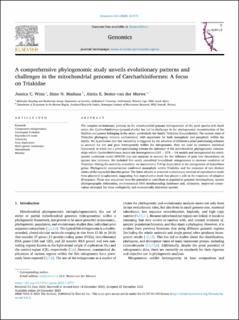| dc.contributor.author | Winn, Jessica | |
| dc.contributor.author | Maduna, Simo | |
| dc.contributor.author | Bester-van der Merwe, Aletta E. | |
| dc.date.accessioned | 2024-01-17T15:02:02Z | |
| dc.date.available | 2024-01-17T15:02:02Z | |
| dc.date.created | 2023-12-30T19:41:01Z | |
| dc.date.issued | 2023-12-30 | |
| dc.identifier.citation | Winn, J. C., Maduna, S. N., & Bester-van der Merwe, A. E. (2024). A comprehensive phylogenomic study unveils evolutionary patterns and challenges in the mitochondrial genomes of Carcharhiniformes: A focus on Triakidae. Genomics, 116(1), 110771. | en_US |
| dc.identifier.issn | 0888-7543 | |
| dc.identifier.uri | https://hdl.handle.net/11250/3112288 | |
| dc.description.abstract | The complex evolutionary patterns in the mitochondrial genome (mitogenome) of the most species-rich shark order, the Carcharhiniformes (ground sharks) has led to challenges in the phylogenomic reconstruction of the families and genera belonging to the order, particularly the family Triakidae (houndsharks). The current state of Triakidae phylogeny remains controversial, with arguments for both monophyly and paraphyly within the family. We hypothesize that this variability is triggered by the selection of different a priori partitioning schemes to account for site and gene heterogeneity within the mitogenome. Here we used an extensive statistical framework to select the a priori partitioning scheme for inference of the mitochondrial phylogenomic relationships within Carcharhiniformes, tested site heterogeneous CAT + GTR + G4 models and incorporated the multi-species coalescent model (MSCM) into our analyses to account for the influence of gene tree discordance on species tree inference. We included five newly assembled houndshark mitogenomes to increase resolution of Triakidae. During the assembly procedure, we uncovered a 714 bp-duplication in the mitogenome of Galeorhinus galeus. Phylogenetic reconstruction confirmed monophyly within Triakidae and the existence of two distinct clades of the expanded Mustelus genus. The latter alludes to potential evolutionary reversal of reproductive mode from placental to aplacental, suggesting that reproductive mode has played a role in the trajectory of adaptive divergence. These new sequences have the potential to contribute to population genomic investigations, species phylogeography delineation, environmental DNA metabarcoding databases and, ultimately, improved conservation strategies for these ecologically and economically important species. | en_US |
| dc.language.iso | eng | en_US |
| dc.publisher | Elsevier Inc. | en_US |
| dc.rights | Attribution-NonCommercial-NoDerivatives 4.0 Internasjonal | * |
| dc.rights.uri | http://creativecommons.org/licenses/by-nc-nd/4.0/deed.no | * |
| dc.subject | Phylogenomics | en_US |
| dc.subject | Phylogenomics | en_US |
| dc.subject | Mitochondrial genomes | en_US |
| dc.subject | Mitochondrial genomes | en_US |
| dc.title | A comprehensive phylogenomic study unveils evolutionary patterns and challenges in the mitochondrial genomes of Carcharhiniformes: A focus on Triakidae | en_US |
| dc.type | Peer reviewed | en_US |
| dc.type | Journal article | en_US |
| dc.description.version | publishedVersion | en_US |
| dc.rights.holder | © 2023 The Authors | en_US |
| dc.subject.nsi | VDP::Genetikk og genomikk: 474 | en_US |
| dc.subject.nsi | VDP::Genetics and genomics: 474 | en_US |
| dc.source.volume | 116 | en_US |
| dc.source.journal | Genomics | en_US |
| dc.source.issue | 1 | en_US |
| dc.identifier.doi | 10.1016/j.ygeno.2023.110771 | |
| dc.identifier.cristin | 2218233 | |
| dc.source.articlenumber | 110771 | en_US |
| cristin.ispublished | true | |
| cristin.fulltext | original | |
| cristin.qualitycode | 1 | |

